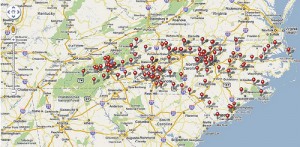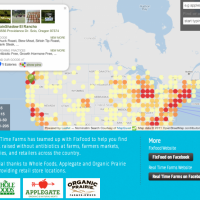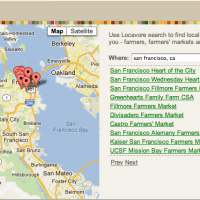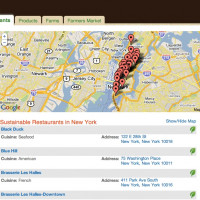Startups, data enthusiasts, researchers, and policy makers all have a reason to start caring about the USDA’s annual National Farmers Market Directory: more comprehensive data will make it easier to build better applications, make more strategic business decisions, conduct research, and improve policy decisions. Every year the Agricultural Marketing Service at the USDA produces the National Farmers Market Directory, which lists farmers market locations and hours. After last year’s success with releasing the data in downloadable format, the USDA hopes to release even more data this year, including the number of vendors at a given market and payment information, particularly if a market participates in federal nutrition benefit programs.
Debra Tropp, Branch Chief, Farmers Market and Direct Marketing Research at U.S. Department of Agriculture, was kind enough to answer some questions about the Directory, why it’s important, and how we can help encourage our Farmers Market Managers to update their listing.
_______________________
Danielle Gould: What is the USDA’s National Farmers MarketDirectory? What kinds of information are collected about the markets?
Debra Tropp: The USDA National Farmers Market Directory is exactly what it sounds like: a national annual directory of farmers markets assembled by the Agricultural Marketing Service at the USDA. The USDA has been producing the National Farmers Market Directory since 1994. At that point, we counted about 1750 farmers markets. Now the Directory lists over 6,300.
The Directory lists the who, what and where of farmers markets — like when they are open, where they are, and how many vendors are at each. A look through the Directory will also allow you to see which markets take credit cards, SNAP (Supplemental Nutrition Assistance Program) payments, or any other payment alternatives and federal nutrition program benefits.
The USDA National Farmers Market Directory is not only used by consumers looking for a nearby place to get fresh, healthy food, but also by policymakers, media representatives, researchers, funders and others interested in the health and well-being of the farmers market sector.
DG: Why is it important for market managers to update their listing?
DT: It’s important for market managers to update their listing in the USDA National Farmers Market Directory because the more accurate it is, the better it is for everyone. USDA National Farmers Market Directory is sometimes considered the “official” list of the country’s farmers markets. The USDA uses it to benchmark how direct to consumer marketing is growing and better understand where and when farmers markets operate and how they help create additional market outlets for producers, especially small and mid-sized farms. Congress, policy advocates and the research community consult it when considering policies that might affect regional food systems, food access and agriculture. The press cites it all the time in stories about farmers market growth and local/regional food production. And of course, customers use it when looking for a farmers market in their town or a town they might be visiting.
But the most important reason for market managers to update their own listing in the USDA National Farmers Market Directory is because the USDA can’t do it alone. We don’t have the staff or capacity to go out there and touch each market directly. Besides, we know market managers have more of the details about their markets than the USDA ever will. By having market managers update their listings we trust that we are getting the most accurate information about farmers markets all over the country in a timely fashion. It’s quick, easy, free, and a really good investment of time since the USDA Farmers Market Directory has gotten over 153,000 page views since the beginning of 2011.
DG: How does the USDA collect information about farmers markets across the United States? How much of that information will be made available to the public?
DT: Market managers can update their listings on the USDA National Farmers Market Directory easily and quickly at www.usdadirectoryupdate.com .
All managers need to do is fill out these form and hit submit. We do all the work on the back end to organize the data into a searchable Directory format and maps which will be released in time for National Farmers Market Week (August 7-13). Last year, we also released data about farmers market locations in spreadsheet form. This year, we hope to release even more data in this format, such as if farmers markets participate in federal nutrition benefit programs like SNAP, and how many vendors are at each market.
 DG: Last year, the USDA launched mapping features allowing consumers to easily find local markets and reformatted data sets to make it easier for developers and researchers to use the data. Have you had any interesting use cases?
DG: Last year, the USDA launched mapping features allowing consumers to easily find local markets and reformatted data sets to make it easier for developers and researchers to use the data. Have you had any interesting use cases?
DT: When we released the data set and the maps last year, we knew it would be a big deal. But we really didn’t anticipate what a big deal it would be. We’ve seen some really interesting and exciting uses of the data from places like Real Time Farms, which is using the USDA data as part of their open source platform about traceability and local food. The EatWellGuide has also used the Farmers Market Directory data in their extensive regional travel eating guides. Here in the USDA, the farmers market directory data is also being put to work in the USDA Food Environment Atlas. We’ve heard other stories too, like programmers using the data to develop platforms for small producers looking for farmers market opportunities and other GIS mapping projects.
DG: What kind of challenges does your department face with making that data available and machine-readable?
DT: We know that clever tech folks, farmers market advocates, researchers and local food practitioners can use this data in ways that we can’t even imagine. We want to be able to deliver data and information that is useable to them and we are doing our best to do that. Our IT Department has been really supportive and helpful on this project, but they also have limited capacity and resources, so some of our biggest challenges are simply operational. And, often we don’t know exactly what form or platform would be of best use to folks out there, so we welcome you to share your feedback on that, and anything else about the Directory, at directoryupdates@ams.usda.gov .
DG: Will you be launching any new features or additional data this year?
DT: Every year that we update the Directory, we also update the questions. We always want to know where and when markets are open so shoppers can find them. This year, we are asking a few more things. For instance, we want to know if farmers markets have closed so we don’t send customers to farmers markets that no longer exist. We are also asking where specifically farmers markets are located – like a church, school or park. This might help civic planners, faith based institutions and municipalities assess if farmers markets are a good add to their community. In addition, last year we counted nearly 900 farmers markets operating in winter and off season months, and since there is a bounty of interest in year round farmers markets, we are really interested to know if farmers markets are changing locations, or making any other adjustments, based on the season.
DG: What can the food+tech community do to help encourage market managers to update their listing?
DT: The best and simplest thing to do is ask your market manager if they have updated their listing in the 2011 USDA Farmers Market Directory at . The deadline to be included in the 2011 Directory is May 27. The other thing to do is to tell farmers market managers if you have used the data or the Directory, and if so how. That way they can know it is being used in a variety of ways by a variety of people.







